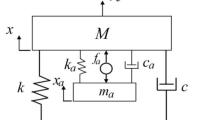Abstract
In the classic form of the Dynamic Vibration Absorber (DVA), a damped DVA is attached to an undamped primary mass, and the main tuning objective is to minimize the dynamic response of the primary mass. Recently proposed structural systems with the selfcontrol ability such as controlled mega-substructure and core tubes with suspension systems use part of the main structure as a dynamic vibration absorber. Because the DVA in the self-control structural systems is a part of the main structure, the control objective of these kinds of systems is dual not only to limit the motion of the primary system but also to reduce the vibration of the DVA. In the present study, the simplified classic model of the DVA with the primary mass under the harmonic excitation is studied and the fixed-point theory is used to derive the optimum parameters of the DVA to minimize the maximum displacement and acceleration responses of the DVA. The effects of different design parameters such as the mass and stiffness ratios of the DVA on the response of the system are investigated. It is shown that the coordinates of one of the fixed points in both displacement and acceleration responses of the DVA are independent of the natural frequency and damping ratios. This point plays an important role in the optimization procedure. For a specific range of the mass ratios of the DVA, the maximum response of the DVA is larger than that of the primary mass; therefore, optimization based on the response of the DVA yields a better result for the self-control structural system.
Similar content being viewed by others
References
Asami, T., Nishihara, O., and Amr, M. (2002). “Analytical solutions to h∞ and h2 optimization of dynamic vibration absorbers attached to damped linear systems.” J. Vib. Acoust., vol. 124, no. 2, pp. 284–295, DOI: 10.1115/1.1456458.
Brock, J. E. (1946). “A note on the damped vibration absorber.” ASME J. Appl. Mech., Vol. 13, No. 4, A-284.
Brown, B. and Singh, T. (2011). “Minimax design of vibration absorbers for linear damper systems.” J. Sound Vib., vol. 330, pp. 2437–2448, DOI: 10.1016/j.jsv.2010.12.002.
Feng, M. Q. and Mita, A. (1995). “Vibration control of tall buildings using mega sub configuration.” J. Eng. Mech., vol. 121, no. 10, pp. 1082–1088, DOI: 10.1061/(ASCE)0733-9399(1995)121:10(1082).
Hahnkamm, E. (1932). “Die dampfung von fundaments-chwingungen bei veranderlicher erregergrequenz.” Ing. Arch., vol. 4, pp. 192–201.
Limazie, T., Zhang, X., and Wang, X. (2013). “Vibration control parameters investigation of the Mega-Sub Controlled Structure System (MSCSS).” EARTHQ. STRUCT, vol. 5, no. 2, pp. 225–237, DOI: 10.12989/eas.2013.5.2.225.
Liu, K. and Coppola, G. (2010). “Optimal design of damped dynamic vibration absorber for damped primary systems.” Trans. Can. Soc. Mech. Eng., vol. 34, no. 1, pp. 119–135, DOI: 10.1016/j.engstruct. 2007.03.007.
Liu, Y. and Lu, Z. (2014). “Seismic performance and story-based stability of suspended buildings.” Adv. Struct. Eng., vol. 17, no. 10, pp. 1531–1550, DOI: 10.1260/1369-4332.17.10.1531.
Makino, A., Imamiya, J., and Sahashi, N. (2008). “Seismic vibration control of a high-rise R.C. building by a large tuned mass damper utilizing whole weight of the top floor.” The 14th World Conference on Earthquake Engineering, Beijing, China.
Nishihara, O. and Asami, T. (2002). “Closed-Form solutions to the exact optimizations of dynamic vibration absorbers (Minimizations of the Maximum Amplitude Magnification Factors).” J. Vib. Acoust, vol. 124, no. 4, pp. 576–582, DOI:10.1115/1.1500335.
Preumont, A. (1994). “Random vibration and spectral analysis.” Kluwer Academic Publishers, Dordrecht.
Rao, S. S. (1995). “Mechanical vibration.” 3rd Edition, Addison-Wesley Company, New York, USA.
Viana, F. A. C., Kotinda, G. I., Rade, D. A., and SteffenJr, V. (2008). “Tuning dynamic vibration absorbers by using ant colony optimization.” Comput. Struct., vol. 86, Nos. 13–14, pp. 1539–1549, DOI: 10.1016/j.compstruc.2007.05.009.
Warburton, G. B. (1981). “Optimum absorber parameters for minimizing vibration response.” Earthq. Arthq. Eng. Struct. D., vol. 9, pp. 251–262, DOI: 10.1002/eqe.4290090306.
Warburton, G. B. (1982). “Optimum absorber parameters for various combinations of response and excitation parameters.” Earthq. Arthq. Eng. Struct. D., vol. 10, pp. 381–401, DOI: 10.1002/eqe.4290100304.
Wang, Ch., Lü, Z., and Tu, Y. (2011). “Dynamic responses of core-tubes with semi-flexible suspension systems linked by viscoelastic dampers under earthquake excitation.” Adv. Struct. Eng., vol. 14, no. 5, pp. 801–813, DOI: 10.1260/1369-4332.14.5.801.
Wong, W. and Cheung, Y. (2008). “Optimal design of a damped dynamic vibration absorber for vibration control of structure excited by ground motion.” Engineering Structures, vol. 30, pp. 282–286, DOI: 10.1016/j.engstruct.2007.03.007.
Zhang, X., Qin, X., Cherry, S., Lian, L., Zhang, J., and Jiang J. (2009). “A new proposed passive mega-sub controlled structure and response control.” J. Earthquake Eng., vol. 13, pp. 252–274, DOI: 10.1080/13632460802347422.
Zhang, X., Zhang, J. L., Wang, D., and Jiang, J. S. (2005). “Controlling characteristics of passive mega-sub controlled frame subjected to random wind loads.” J. Eng. Mech., vol. 131, no. 10, pp. 1046–1055, DOI: 10.1061/(ASCE)0733-9399(2005)131:10(1046).
Author information
Authors and Affiliations
Corresponding author
Rights and permissions
About this article
Cite this article
Kalehsar, H.E., Khodaie, N. Optimization of Response of a Dynamic Vibration Absorber Forming Part of the Main System by the Fixed-point Theory. KSCE J Civ Eng 22, 2354–2361 (2018). https://doi.org/10.1007/s12205-017-1237-y
Received:
Accepted:
Published:
Issue Date:
DOI: https://doi.org/10.1007/s12205-017-1237-y




